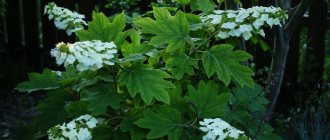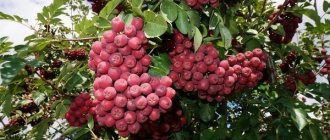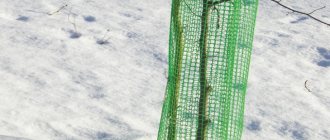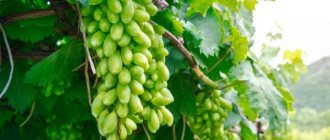Beautiful and productive beds with your own hands
Home › Bushes and trees › Features of planting and rules for growing oak-leaved mountain ash
A tree that is beautiful at any time of its development - with young foliage, white flowers, and picturesque scarlet berries. “Ah, this red rowan among the autumn yellowness...”
How many songs and poems have been written about her! How much benefit it brings to people! I will try to tell you in detail in this article how to plant and grow oakleaf rowan on your site.
Rowan is characterized by high winter hardiness and drought resistance. It grows successfully in harsh climates. Possessing an excellent decorative appearance, it is widely used in landscape design.
In folk medicine and cooking, rowan occupies one of the places of honor, due to the presence of a huge amount of vitamins and minerals in its berries.
In ancient times, mountain ash was credited with magical properties. It was believed that she protected the courtyard from evil spirits. Rowan branches were hung throughout the apartment to protect household members from the evil eye. Rowan beads were also considered a powerful amulet for women and girls.
The beauty of four seasons
In early spring, oakleaf rowan, planting and caring for which is not particularly difficult, is dressed in a transparent mesh of young foliage. At the beginning of summer, fully blossomed green leaves become the backdrop for gorgeous white inflorescences.
In the second half of the hot season, during the ripening of the berries, another change in colors occurs; The richest shades can be admired in mid-autumn. In winter, rowan with clusters dusted with snow becomes the most beautiful inhabitant of the sleeping garden.
Description of rowan oakleaf
Oakleaf rowan is a spectacular tall (10 to 12 meters in height) representative of the genus Sorbus. At a young age, it is characterized by a narrow pyramidal crown, which over time takes on a spherical shape with a diameter of 5-7 meters. The leaves at the base are simple, with a deep (almost to the veins) dissection; closer to the top they are less dissected and are similar in shape to oak leaves. The leaf blades are dark green in the upper plane, light (grayish or white) underneath and covered with fluff. Shoots up to 2 years old are characterized by a gray-brown color; older branches have a light brown color.
Among oak-leaved trees, intermediate rowan is very popular, most commonly found in northern Europe, Scandinavia and the Baltic countries. Due to its location, the plant is also called “Swedish” rowan. The tree reaches a height of 12-15 meters. Unlike the oakleaf rowan with complex leaves, the intermediate rowan has solid and simple leaf blades, with shallow, heavily pubescent lobes, which is why the foliage crown appears silver. Leaf fall occurs after the first frost. The bark of the trunk is smooth and gray in color. The inflorescences are wide, corymbose, pubescent. The flowers are about 1.2 cm in diameter. The fruits are red-orange in color, up to 1 cm in diameter, and are bitter when consumed fresh.
The value of rowan fruits
The berries are dense, juicy orange, with felt pubescence. Ripen at the end of September. When fresh, they are not very tasty, as they have a tart-bitter taste due to the high tannin content. When the berries freeze, this defect partially disappears, and when processed and dried, it disappears completely. To ensure high-quality preservation of the available beneficial substances, it is recommended to collect fruits in whole bunches.
Rowan fruits contain a whole range of useful substances: nutritional vitamins, sugars, pectins, organic acids. In terms of the presence of vitamin C, rowan is close to lemon and black currant; It surpasses even carrots in carotene content. To meet the daily requirement for vitamins P and C, as well as carotene, consuming one bunch per day is enough. Rowan fruits occupy first positions among horticultural crops in terms of their content of biologically active compounds.
Rowan fruits have anti-edematous and choleretic properties and are able to inhibit fermentation processes in the intestines. In folk medicine, they are widely used as a diuretic and tonic, significantly reduce capillary fragility and have a beneficial effect on cholesterol metabolism. Since ancient times, the medicinal culture has been valued for its antiscorbutic properties; today it is used in the treatment of atherosclerosis. Fresh berry juice helps with hemorrhoids and gastritis; drinking it is useful for low acidity of gastric juice - take a teaspoon before meals.
Contraindications for internal or external use of rowan for medicinal purposes
Despite the fact that rowan has a lot of useful and healing properties, not everyone can use it. Admission is contraindicated for:
- pregnancy;
- breastfeeding (only with doctor's permission);
- high stomach acidity;
- increased blood clotting, tendency to form blood clots;
- ischemia;
- after heart attack and stroke.
There is no consensus on the benefits of rowan for hypotensive patients. Many experts believe that the berry is contraindicated for low blood pressure. Others are sure that it does not lower blood pressure, but normalizes it. Therefore, the plant should be used with hypotension with caution, monitoring changes in well-being.
Rowan in folk medicine
Rowan leaves, which contain a large number of phytoncides and vitamins, also have medicinal properties. This feature allows the leaf mass to be used when raising domestic animals and birds as a useful supplement. To avoid the development of rot, when storing rowan leaf mass, root crops and tubers are transferred to storage. It is believed that vegetables planted between rows of garden crops will not be affected by fungal diseases.
There is a belief that oakleaf rowan has cleansing properties and can make swamp and musty water drinkable. To do this, you need to immerse a fresh branch of the plant in the liquid. After 3 hours, the unpleasant smell and taste will disappear, and pathogenic microbes will die.
Diseases and pests
It is believed that oakleaf rowan has strong immunity and rarely gets sick. But in late May and early June, due to unfavorable weather conditions, infectious diseases can spread en masse:
- powdery mildew - white cobwebby coating on leaf blades;
- rust - orange-yellow spots with dark brown tubercles, due to which the leaves are deformed;
- brown spot - brown spots with a reddish border on the upper side of the leaves;
- gray spotting - gray spots on irregularly shaped leaf blades;
- scab - brown spots with radiant edges on which a coating of mycelium with spores develops;
- ring mosaic - yellow rings with a green center, forming a mosaic pattern on the leaves.
Pests of oakleaf rowan include:
- weevil - a small brown beetle that feeds on the buds, eating the core;
- bark beetle - a small beetle that gnaws passages in the bark;
- moths - a caterpillar 2 cm long, appears before flowering and destroys buds, leaves, flowers;
- Rowan aphid - sucks juices from leaves.
Growing area
Oakleaf rowan, the beneficial properties of which are highly valued by experts in traditional medicine, is characterized by high development activity and annually produces 30-50 cm of growth. The average life expectancy is 60-120 years. Garden culture is unpretentious to the conditions of its maintenance and is capable of developing in conditions that are uncomfortable for many garden plants. Most of all it prefers fertile, moist soils mixed with lime. Oakleaf rowan (intermediate or Swedish) is used in urban landscaping, for lining highways and roads. True, due to air pollution, soil pollution, the use of icy reagents and high pedestrian loads that compact the soil, the life of oakleaf rowan in a metropolis is reduced by 10-20 years. But this does not at all affect the fruiting time of such an attractive crop: rowan produces its first harvests in the 8-10th year of planting.
Planting and caring for oakleaf rowan
The best time to plant oakleaf varieties is autumn. To grow a good tree, it is necessary to provide the plant with all the conditions.
Compliance with certain rules will help the seedling to fully develop, grow and bear fruit:
- Competent choice of site for planting seedlings.
- Use of moisture-retaining soil mixture.
- Regular feeding.
- Proper pruning.
- Provision of light.
The average lifespan of a tree is about 120 years. But if it grows in a metropolis, then its lifespan is reduced by 10-20 years.
Rowan gets along well with coniferous trees, as well as next to viburnum and honeysuckle
Recommended timing
To find out what period is best for planting a plant, you need to determine the climate of the area.
If planting is planned in the central region, then it should be carried out from September 15 to mid-October. In southern latitudes, the dates are shifted to October - early November.
For the northern regions, the entire month of September and early October will be suitable. Residents of the Urals and Siberia need to have time to plant seedlings during the fall. Unstable weather prevails in these parts, especially in spring. If we take into account the autumn period, then, on the contrary, it is characterized by normal temperatures and moderate amounts of precipitation.
If the deadlines are missed, the seedling is saved until next year.
Choosing a suitable location
Oakleaf rowan is characterized by its ability to grow in areas unsuitable for growing other crops. The tree bears fruit both in the city and in the garden.
The most important thing to consider before planting is the illumination of the seat. In the absence of light, the tree will stretch in length. This will not allow the crown to form a beautiful shape.
Peat soil will also be detrimental to the tree. Fertile loams are the best option for planting.
Once the location has been successfully found, you need to dig a small hole. So that the roots can spread unhindered, there should be some space left next to the hole.
Selection and preparation of planting material
When purchasing seedlings, you need to pay attention to the root system of oakleaf rowan. She must be healthy, without any damage. A well-developed system has 2-3 branches more than 20 cm long. You should not purchase seedlings with dry roots and wrinkled bark.
Before planting, the plant should be prepared. To do this, you need to cut out injured and dry stems. Also, all leaf plates are torn off from the branches. This must be done carefully so as not to injure the kidneys in the sinuses.
Rowan can survive severe frosts and grow in places with polluted air.
Landing algorithm
Planting oakleaf rowan is carried out according to the following scheme:
- Dig a planting hole 60 cm deep and wide.
- Fertilizers (compost, rotted manure) and superphosphate are placed at the bottom of the hole.
- The roots of the seedlings are shortened and then placed in the center of the hole.
- The hole is filled with soil mixture and then watered with water.
- All that remains is to mulch the tree trunk circle with mowed grass.
Attention! Oakleaf rowan is an unpretentious plant, but it requires care.
For careful treatment, the seedling will reward the gardener with beautiful flowering and a rich harvest.
Rowan in landscape design
Being an excellent decoration for the garden, oak-leaved mountain ash goes well in plantings with fir, spruce, and pine trees; looks harmonious among ash and linden trees. Effective in hedges and group plantings (in the foreground and background), it is a beautiful background for perennial herbaceous plants. Many types of rowan easily get along with honeysuckle, barberry, rose, spirea, and viburnum.
Thanks to the structure of the root system, the plant grows normally in areas inconvenient for other crops, which allows it to be used to strengthen the walls of ravines.
Culture in the landscape
Oakleaf rowan, unlike its other species, is resistant to smoke and gas. It is also resistant to frost (can withstand up to -28 C) and drought. All these qualities allow her to delight us for many years.
In addition to these, rowan has a number of other positive characteristics: it looks very aesthetically pleasing and will fit perfectly into any landscape. Oakleaf rowan can decorate a garden at any time of the year.
Oakleaf rowan can decorate any summer cottage
The tree looks impressive as a hedge, in multi-level group plantings, as a background for perennial shrubs and flowers, as well as for urban landscaping. Due to the fact that the root of the plant allows planting in places that are inconvenient for other crops, rowan can also be used to strengthen ravines.
The tree goes well and looks harmonious with coniferous trees: blue and regular spruce, fir, pine, juniper.
The tree will not only give aesthetic pleasure, but will also delight you with valuable fruits.
Development conditions
Oakleaf rowan, the description of which evokes a great desire to acquire such a plant on your own plot, is a drought-resistant and frost-resistant crop that is unpretentious to soils. The plant is uncomfortable on sandy and peaty swampy lands. Growth and development are detrimentally affected by the proximity of groundwater and excessive soil moisture. Garden culture is demanding of light. If it is deficient, it can grow up to 20 meters, losing its crown shape and natural grace. A valuable quality of rowan is its high winter hardiness, so the plant can be planted in regions with harsh climates.
Pros and cons of oakleaf rowan
The frequent use of oak-leaved mountain ash in landscape design is explained by a number of its advantages:
- unpretentiousness in care;
- resistance to drought, environmental pollution, low temperatures;
- undemanding to soils;
- frost resistance;
- the presence of strong immunity to fungal diseases;
- attractive appearance at any time of the year and at any age;
- medicinal properties of berries;
- widespread use of fruits in cooking.
Planting rowan
The best time to plant rowan is autumn. At the bottom of the hole in which the oakleaf rowan will be placed, you should lay the main fertilizer, consisting of 2 parts of compost or rotted manure and 1 part of fertile soil (the top layer of soil obtained during the digging of the planting hole) and river sand.
Oakleaf rowan, seedlings of which can be purchased at any garden store, is characterized by rapid establishment. Prices for planting material vary. For example, a 2-meter tree costs from 500 to 1,500 rubles.
At first, it is important for the plant to provide watering when the weather is too hot and to remove weeds from the area near the trunk.
Landing
Planting oakleaf rowan is not difficult; planting is done in the fall according to the following scheme:
- Dig a planting hole measuring 60*60*60. Compost, 100 g of potassium fertilizers and 200 g of superphosphate are laid at the bottom of the pit, mixed with fertile soil.
- A seedling is placed in the center of the hole, the roots are carefully distributed and covered with soil so that the root collar is at soil level.
- Water the seedling abundantly and mulch the tree trunk with straw, pine needles or dry grass.
Feeding activities
It is recommended to start feeding from the third year of life:
- in early spring, before flowering, it is recommended to apply 20 g of nitrogen, 15 g of potassium and 25 g of phosphorus fertilizers per 1 square meter of tree trunk circle;
- in the summer season - 10 g of potassium and phosphorus and 15 g of nitrogen fertilizers;
- in the fall, after harvesting the fruits, 10 g of potassium and phosphorus preparations.
Fertilizers should be scattered over the surface of the soil, and then embedded to a depth of 15 cm by digging. Next, it is recommended to moisten the soil.
Among the pests, the plant can be affected by the rowan moth, which can actively reproduce and infect neighboring fruit trees, preferring apple trees. Due to the high content of phytoncides, rowan is rarely affected by fungal diseases.
Care
Oakleaf rowan is a completely unpretentious plant. But even minimal care and attention will be rewarded with an excellent decorative appearance, lush flowering, and an abundant harvest of picturesque and extremely healthy berries.
Watering, loosening, mulching
Young seedlings need more frequent watering. It is necessary to form sides from the soil along the edges of the tree trunk circle so that water is retained in it. Each time after watering, it is advisable to perform shallow loosening and mulching with hay or straw. Be sure to remove weeds in a timely manner.
When oakleaf rowan trees become mature, they will have enough water coming from precipitation, with the exception of the period of prolonged summer heat.
Top dressing
After the third season of life, oakleaf rowan trees need to be fed:
- In the spring, before flowering begins, apply 20 g of nitrogen, 15 g of potassium and 25 g of phosphorus fertilizers per tree.
- In the summer, you need to feed the rowan with the following composition: 10 g of potassium, 15 g of nitrogen and 10 g of phosphorus fertilizers.
- When the harvest is completed, 10 g of potassium and phosphate fertilizers must be added.
Fertilizers are scattered around the root circle, buried to a depth of 15 cm, and watered the soil.
Trimming
In most cases, oakleaf rowan does not need pruning. Only sanitary pruning is carried out after winter, broken and frostbitten branches are removed.
But if for decorative purposes it is necessary to maintain a certain shape, then pruning is done in early spring before the buds swell.
Remove shoots that grow at an acute angle to the tree trunk so that they do not interfere with the development of correctly positioned branches.
Reproduction
Oakleaf rowan can propagate by seeds, graftings, cuttings, root suckers and layering:
- Propagation by root suckers is often used; this is a simple method. It is necessary in the spring to dig up one of the lateral shoots with the root together, carefully separate it from the main tree and plant it in a new place according to the above scheme.
- It is a little more difficult to propagate using root cuttings. To do this, at the end of May, you need to dig up a side root, carefully separate it along with small root shoots, and dig it at an angle into loose, nutritious soil with the cut up, so that the cut is at ground level. The cut must be sprinkled with crushed activated carbon.
- Cuttings are also a fairly simple method of propagation; rooting of cuttings occurs in 60% of cases.
- The seed method is the most labor-intensive and time-consuming. Before sowing, soak the seeds for 3-4 hours; after sowing, cover the beds with a thick layer of mulch from fallen leaves. By spring, dismantle the shelter, seedlings will begin to appear, which by autumn will have grown and become stronger, and it will be possible to transplant them to a permanent place in the usual way.
Wintering
Since oakleaf rowan has high frost resistance, it can survive -35 degrees. In those regions where the climate is not too harsh, trees may not be covered for the winter.
However, if the rowan trees are young, with weak roots, or severe frosts are expected, it is necessary to take care of shelter. To do this, trees are covered with dry soil in late autumn. A 10 cm thick layer of fallen leaves is poured on top, or covered with spruce branches. The top part of the trees is not covered.
Diseases and pests
Oakleaf rowan has high immunity to various diseases. The most common pest of rowan is the rowan moth. To protect against it, spray with insecticides (Fufanon, Actellik) before buds open and immediately after flowering.
Reproduction: methods
Oakleaf rowan, the fruits of which are valued for their rich vitamin composition, is propagated in several ways: by seed, cuttings and grafting. The seed method is the simplest, but longer than the others. First, the plant seeds need to undergo long-term stratification, starting in the fall. Then, before planting, soak for 3-4 hours. It is recommended to sow in the autumn, with the crops insulated with mulch (a thick layer of fallen leaves). It is also recommended to plant plants obtained from seedlings in a permanent place of growth in the fall.
How does oakleaf rowan propagate by grafting? The price of plant seedlings may not be affordable for everyone, as it is quite high, so you can propagate mountain ash yourself. Almost all varieties of plants are grafted onto the mountain ash at the end of July - beginning of August. The form of this procedure is budding with a sleeping “eye”.
Propagation by cuttings is characterized by a high percentage of rooting of young plants - about 60%.
Reproduction
Oakleaf rowan can be propagated:
- seeds;
- budding;
- cuttings;
- basal shoots;
- layering.
The seed method is rarely used due to its labor-intensive and time-consuming nature. The first plant shoots appear a few months after sowing.
The budding of oakleaf rowan begins at the beginning of August. Its plastic skin ensures high survival rate. After a year, the rootstock is cut to a thorn, the buds are removed, and the grown shoot is tied to the thorn.
The cutting method consists of separating the lateral root of the mother plant with small shoots and digging it into loose soil, cut side up.
Rooting is possible with ordinary cuttings taken from shoots. Their rooting rate is 60%.
Layering is done using long young branches, dug in and pinned into a special furrow. After rooting, the plant is separated and planted in a permanent place.
The basal shoots of oakleaf rowan constantly appear next to the trunk. To propagate, it is enough to carefully separate, dig up and plant the root shoot in a new place.
Rowan in cooking
The fruits are used in the preparation of jams, compotes, kvass, jelly, liqueurs, marshmallows, candied fruits; in dry or dried form, they can be stored at room temperature and consumed throughout the vitamin-free period.
At home, delicious jelly is prepared from rowan berries. Rowan berries are collected after frost or specially frozen in the refrigerator, washed, and filled with water at the rate of 1 cup of berries and 2 cups of water. Boil for 10-15 minutes. The mass is squeezed out and boiled with 1 kg of sugar to 2/3 of the original volume. Pour hot into glass containers and roll up.











